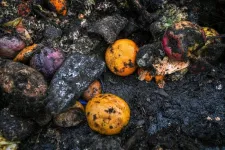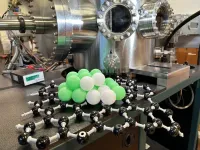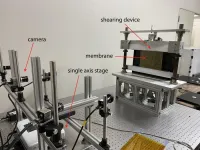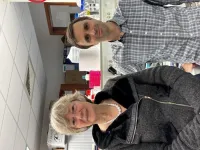(Press-News.org) The United States generates more food waste than all but two countries. To address this, the federal government set a goal to cut food waste in half by 2030 compared to 2016 levels, to about 164 pounds per person annually. But a new study published in Nature Food and led by University of California, Davis, reveals that current state policies are falling short. Since 2016, per capita food waste has increased instead of decreasing.
“We’re just five years away from 2030 so it’s quite alarming how little progress we have made,” said first author Sarah Kakadellis, a postdoctoral researcher with the UC Davis Department of Food Science and Technology. “More comprehensive policies need to be implemented as soon as possible.”
The study examined how state policies align with the federal targets. States determine what policies to implement. Researchers found that state policies emphasize food waste recycling methods like composting and anerobic digestion, rather than prevention and rescue strategies, such as donating to food banks or repurposing food for animal feed. In 2021, the U.S. Environmental Protection Agency excluded recycling from its definition of food waste to reflect environmental and ethical dimensions.
“We have a huge portion of the American population that is suffering from food insecurity yet we waste more than a third of the food we produce,” said Kakadellis. “Instead of recycling our excess food, we should be redirecting as much as we can to populations that need it.”
Recycling or composting food also has environmental downsides. While they keep food out of landfills, food production still consumes significant resources.
“When we waste food, we’re wasting all the resources it takes to grow that food, including energy, water and fertilizer. Meanwhile, wasted food represents 8-10% of global greenhouse gas emissions,” said principal investigator Edward Spang, an associate professor in the Department of Food Science and Technology and director of the Robert Mondavi Institute for Wine and Food Science at UC Davis.
Evaluating policy impact
Researchers assessed states’ potential to reduce food waste through four policy areas: prevention (date labeling), rescue (liability protection and tax incentives), repurposing (animal feed), and recycling (organic waste bans and waste recycling laws). They found that recycling policies offered the largest diversion potential. But even when including recycling, many states still fell short of the target. Only California, Vermont and Arizona were projected to achieve the goal of reducing waste to 164 pounds per person.
Under the revised EPA definition that excludes recycling, states could divert as little as 11 pounds to as high as 30 pounds per person. Washington could divert close to a third of its current food waste, followed closely by California at 26%.
Americans would still generate an average of 328 pounds of food waste per person annually, double the federal target. Despite ranking last for its diversion potential, Arkansas was the only state that came closest to reaching the federal goal of generating 164 pounds of food waste per person by 2030. Kakadellis said it’s important to consider current food waste generation when looking at diversion potential.
Arizona, for example, has the highest potential to divert food waste under existing state policies. It’s also one of the highest generators of food waste. On the other end of the spectrum, Arkansas generates significantly less waste than other states and is close to the national goal, which makes it difficult to make further cuts.
Beyond policy
Kakadellis suggested that the pandemic may have also played a role in the increase in food waste. Food waste declined early in the pandemic when more people were planning and cooking at home and there were fewer catered events. Now, people may be falling back into their old habits.
“When state policies focus on recycling, it’s very easy to think we’re addressing the food waste problem,” said Kakadellis. “Recycling food waste is important but not the only solution, nor should it be the first.”
She said policies should instead focus on food waste prevention and rescue.
Other authors of the study include Selina Mao and Asch Harwood of ReFED.
The research was funded by the National Science Foundation and the United States Department of Agriculture Natural Resources Conservation Service and USDA National Institute of Food and Agriculture.
END
States struggle to curb food waste despite policies
Without stronger measures, federal reduction targets remain out of reach
2025-01-09
ELSE PRESS RELEASES FROM THIS DATE:
Record cold quantum refrigerator paves way for reliable quantum computers
2025-01-09
Quantum computers require extreme cooling to perform reliable calculations. One of the challenges preventing quantum computers from entering society is the difficulty of freezing the qubits to temperatures close to absolute zero. Now, researchers at Chalmers University of Technology, Sweden, and the University of Maryland, USA, have engineered a new type of refrigerator that can autonomously cool superconducting qubits to record low temperatures, paving the way for more reliable quantum computation.
Quantum computers have the potential to revolutionise fundamental technologies in various sectors of society, with applications in medicine, energy, encryption, AI, and logistics. While the building ...
New discovery makes organic solar cells more efficient and stable
2025-01-09
EMBARGO 9.1.2025
New discovery makes organic solar cells more efficient and stable
Researchers at Åbo Akademi University in Finland have identified and eliminated a previously unknown loss mechanism in organic solar cells that makes them more efficient and gives them a longer lifetime. The results provide new insight into how efficiency and stability can be increased in the future.
The work of the Organic Electronics Research Group at Åbo Akademi University was carried out in cooperation with Professor Chang-Qi Ma's group at Suzhou Institute ...
What we eat affects our health — and can alter how our genes function
2025-01-09
Fiber is well known to be an important part of a healthy diet, yet less than 10% of Americans eat the minimum recommended amount. A new study from Stanford Medicine might finally convince us to fill our plates with beans, nuts, cruciferous veggies, avocados and other fiber-rich foods. The research, which will be published in Nature Metabolism on Jan. 9 identified the direct epigenetic effects of two common byproducts of fiber digestion and found that some of the alterations in gene expression had anti-cancer actions.
When we eat fiber, the gut microbiome produces short-chain fatty ...
Lung cancer test predicts survival in early stages better than current methods
2025-01-09
ORACLE test predicts overall cancer survival independent of currently used clinical risk factors, and it has the best predictive power in stage 1 lung cancer.
A high ORACLE score is associated with a higher risk of cancer spread.
ORACLE could potentially be used to pick out patients who would benefit most from chemotherapy.
Researchers at the Francis Crick Institute, the UCL Cancer Institute and UCLH have shown that a test called ORACLE can predict lung cancer survival at the point of diagnosis better than currently used clinical risk factors. This could help doctors make more informed treatment decisions for people with stage ...
Pioneering new mathematical model could help protect privacy and ensure safer use of AI
2025-01-09
UNDER EMBARGO UNTIL 10 AM GMT / 5 AM ET THURSDAY 9 JANUARY 2025
Pioneering new mathematical model could help protect privacy and ensure safer use of AI
AI tools are increasingly being used to track and monitor us both online and in-person, yet their effectiveness comes with big risks. Computer scientists at the Oxford Internet Institute, Imperial College London, and UCLouvain have developed a new mathematical model which could help people better understand the risks posed by AI and assist regulators in protecting peoples’ privacy. The findings have been published today (9 January) in Nature Communications.
For ...
Floods, droughts, then fires: Hydroclimate whiplash is speeding up globally
2025-01-09
Key takeaways
Hydroclimate whiplash – rapid swings between intensely wet and dangerously dry weather – has already increased globally due to climate change, with further large increases expected as warming continues, according to a team of researchers led by UCLA’s Daniel Swain.
The “expanding atmospheric sponge,” or the atmosphere’s ability to evaporate, absorb and release 7% more water for every degree Celsius the planet warms, is a key driver of the whiplash.
Co-management of extreme rainfall or extreme droughts, ...
Scientists fuel sustainable future with catalyst for hydrogen from ammonia
2025-01-09
Scientists have created a catalyst for hydrogen generation from ammonia that becomes more active with time, and by counting atoms revealed changes that boost the catalyst’s performance.
A research team from the University of Nottingham's School of Chemistry, in collaboration with the University of Birmingham and Cardiff University, has developed a novel material consisting of nanosized ruthenium (Ru) clusters anchored on graphitized carbon. These Ru nanoclusters react with ammonia molecules, catalysing splitting ammonia into ...
Discovering hidden wrinkles in spacecraft membrane with a single camera
2025-01-09
Exiting Earth’s gravity takes an enormous amount of fuel and power. Due to this, spacecraft strapped to rockets are limited in their carry capacity and every gram must be accounted for. To lighten the load, thin membranes are being researched as alternative materials, but their plastic wrap property causes wrinkling that can affect operational performance. For this reason, there is a need to develop measurement technology that can accurately detect deformations.
Professor Takashi Iwasa at Osaka Metropolitan University’s Graduate School of Engineering led a team in developing a method for measuring the size of wrinkles ...
Women are less likely to get a lung transplant than men and they spend six weeks longer on the waiting list
2025-01-09
Women are less likely to receive a lung transplant and spend an average of six weeks longer on the waiting list, according to a study published today (Thursday) in ERJ Open Research [1]. However, women who receive a lung transplant are more likely than men to live for five years post-transplant. Based on their findings, the researchers encourage changes in regulation and clinical guidelines to address this inequality.
Lung transplantation is the only treatment for people with end-stage respiratory failure and patients on the waiting list have a high risk ...
Study sheds more light on life expectancy after a dementia diagnosis
2025-01-09
The average life expectancy of people diagnosed with dementia ranges from 9 years at age 60 to 4.5 years at age 85 for women and from 6.5 to just over 2 years, respectively, in men, finds a systematic review of the latest evidence in The BMJ today.
The results also suggest that one third of people with dementia are admitted to a nursing home within three years of diagnosis.
Nearly 10 million people worldwide receive a diagnosis of dementia every year, but survival estimates vary widely, and few ...
LAST 30 PRESS RELEASES:
Making lighter work of calculating fluid and heat flow
Normalizing blood sugar can halve heart attack risk
Lowering blood sugar cuts heart attack risk in people with prediabetes
Study links genetic variants to risk of blinding eye disease in premature infants
Non-opioid ‘pain sponge’ therapy halts cartilage degeneration and relieves chronic pain
AI can pick up cultural values by mimicking how kids learn
China’s ecological redlines offer fast track to 30 x 30 global conservation goal
Invisible indoor threats: emerging household contaminants and their growing risks to human health
Adding antibody treatment to chemo boosts outcomes for children with rare cancer
Germline pathogenic variants among women without a history of breast cancer
Tanning beds triple melanoma risk, potentially causing broad DNA damage
Unique bond identified as key to viral infection speed
Indoor tanning makes youthful skin much older on a genetic level
Mouse model sheds new light on the causes and potential solutions to human GI problems linked to muscular dystrophy
The Journal of Nuclear Medicine ahead-of-print tip sheet: December 12, 2025
Smarter tools for peering into the microscopic world
Applications open for funding to conduct research in the Kinsey Institute archives
Global measure underestimates the severity of food insecurity
Child survivors of critical illness are missing out on timely follow up care
Risk-based vs annual breast cancer screening / the WISDOM randomized clinical trial
University of Toronto launches Electric Vehicle Innovation Ontario to accelerate advanced EV technologies and build Canada’s innovation advantage
Early relapse predicts poor outcomes in aggressive blood cancer
American College of Lifestyle Medicine applauds two CMS models aligned with lifestyle medicine practice and reimbursement
Clinical trial finds cannabis use not a barrier to quitting nicotine vaping
Supplemental nutrition assistance program policies and food insecurity
Switching immune cells to “night mode” could limit damage after a heart attack, study suggests
URI-based Global RIghts Project report spotlights continued troubling trends in worldwide inhumane treatment
Neutrophils are less aggressive at night, explaining why nighttime heart attacks cause less damage than daytime events
Menopausal hormone therapy may not pose breast cancer risk for women with BRCA mutations
Mobile health tool may improve quality of life for adolescent and young adult breast cancer survivors
[Press-News.org] States struggle to curb food waste despite policiesWithout stronger measures, federal reduction targets remain out of reach






